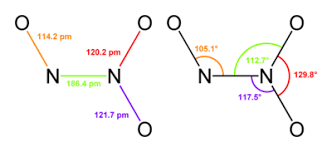Dinitrogen Trioxide Formula
Dinitrogen Trioxide is a deep blue color chemical compound. One can get it by mixing the equal parts of nitrogen dioxide and nitric oxide at cool temperatures like −21 degrees C. It is a powerful oxidizer and it is highly toxic and corrosive. In this article, the student will learn it in detail with Dinitrogen Trioxide Formula and some examples. We shall also discuss the properties and uses here. Let us learn it!
Dinitrogen Trioxide Formula

Concept of Dinitrogen Trioxide:
It is a chemical compound formed by mercury and chlorine with a chemical name as Dinitrogen Trioxide. It is also known as nitrogen sesquioxide. Also, it is a highly toxic nature compound and irritating to the mucous membranes.
Dinitrogen trioxide is a liquid with an unpleasant, sharp odor. It is a planar molecule that exhibits the C-symmetry. It dissociates partially into
The formula for Dinitrogen Trioxide:
Its chemical formula is:
It is produced as an anhydride when the mixture of water with unstable nitrous acid is done. The nitrous acid i.e.
The monoisotopic mass and the exact mass of Nitrogen sesquioxide is 75.991 gram per mole. The number of hydrogen bond donors equals zero whereas the number of hydrogen bond acceptors equal to four. This compound is canonicalized and the number of covalently bonded units equals one.
Chemical Properties of Dinitrogen Trioxide:
It is a popular oxidizing agent and is non-flammable but may cause fires when mixed with combustible materials. It reacts with reducing agents to generate heat and products like some gases. The products may themselves be capable of further reactions for example combustion in the air. It also catalyzes the ignition of phosphine gas. A mixture with caprolactam dissolved in acetic acid is very explosive unless effectively cooled.
Physical Properties of Dinitrogen Trioxide:
Its appearance is Deep blue-tinted gas and is easily soluble in water. Its boiling point is 3.5-degree C, its melting point is -11.7-degree C and density is 1.4 gram per cubic cm.
Uses:
Dinitrogen trioxide is useful as a special purpose fuels due to its highly combustible nature. The chemical only supports combustion and doesn’t actually burn. It is more often in use as an oxidizing agent in combination with other chemical compounds.
Solved Examples on Dinitrogen Trioxide Formula
Q.1: Determine the molar mass of Dinitrogen Trioxide.
Solution: Its chemical formula is:
Hence its molar mass will be:
=
= 76.01 gram per mole.
Thus the molar mass of Dinitrogen Trioxide is 76.01 gram per mole.
Q.2: Discuss some health hazards of Dinitrogen Trioxide.
Solution: Nitrogen sesquioxide is very toxic and corrosive in nature. It can be very fatal if absorbed through the skin or inhaled. On heating, this compound is producing irritating, corrosive, toxic gases. In its liquid form, it may cause severe injury and burns. Fire will produce irritating, corrosive gases. Runoff from fire control may cause pollution.